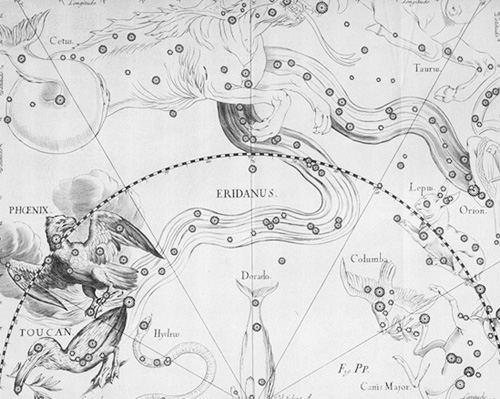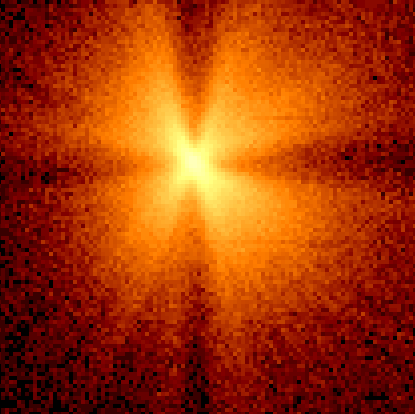| |
![]()
EARTHQUEST
NEWS
Andrew Collins Newsletter Vol. 12 No. 2(August 2009)
iii.
Is it ET? Deep Space
Signal Detected, Source Revealed
First
contact with an intelligent extraterrestrial race would be a grand thing, and
it is hopefully something I might live to see before departing this mortal coil.
So far attempts to listen in on potential ET signals from deep space have provided
only one possible hit, and this was the famous "Wow!" signal received
exactly thirty years ago by the Big Ear radio telescope, operated by Ohio State
University. On August 15, 1979, the facility registered a sudden burst of narrow-band
radio activity, close to 1420 MHz (strangely, the frequency of hydrogen), that
lasted for exactly 72 seconds before vanishing as quickly as it appeared. When
the computer print out recording the freak signal was viewed the following morning
by astrophysicist Jerry R. Ehman, he wrote on it just one word: "Wow!",
hence the name by which the broadcast is remembered today.
The computer print out showing the Wow! signal. Note the sequence of numbers and letters which spell out the strength of the signal. It reads 6EQUJ5, which simply invites interpretation! | What caused the "Wow" signal is entirely unknown. When it was received the Big Ear had been making a sweep of the sky some 2.5 degrees away from the star Chi Sagittarii in the constellation of Sagittarius. It is thought that the transmission was a rapid broadcast from a deep space source somewhere in this sector of the sky. This seems pretty certain. What's less certain, however, is whether or not the signal was of natural or artificial origin. |
All that can be said is that nothing similar to the "Wow!" signal has
been detected again, despite attempts to check the same astronomical coordinates
using more powerful radio telescopes. Thus the "Wow!" signal remains
as the only possible transmission received from ET.
However, all this is
about to change, for I have learnt that in the first week of December 2008 another
unknown signal from deep space was received at an astronomical observatory at
the University of Western Sydney, run as part of the OZ OSETI Project (OSETI stands
for Optical Search for Extra-terrestrial Intelligence). Yet its chairman, Dr Ragbir
Bhathal of the School of Engineering at UWS, the discoverer of the broadcast,
is being cautious about revealing too much information until he has eliminated
all possible natural causes for the event. Despite this, reports of the discovery
were leaked to the media, with the first major feature appearing in the Weekend
Australian back in May 2009.
Yet Dr Bhathal will not be drawn any further,
admitting in a blog posted on May 29 that "in science and in particular physics
we have to be doubly sure that what we received in our sophisticated high-tech
instrumentation is genuine.
"It is certainly not yet the time to break
open the champagne bottle lying on my desk in the Observatory,' he added.
The
story actually begins in the year 2000 when Dr Bhathal decided to look for alternatives
for the detection of potentially intelligent deep space signals. Up until this
time the main technique had been to scan the sky using radio telescopes attuned
to narrowband radio frequencies likely to be used for interstellar broadcasts.
It was in this manner that the "Wow!" message was received in 1979,
and SETI (the Search for Extraterrestrial Intelligence) has operated for the past
40 years.
Having concluded that ETI (extra-terrestrial intelligences)
might not be sending out deep space signals using radio waves, Dr Bhathal decided
to begin a search of the optical spectrum in the belief that advanced civilizations
could utilize laser light pulses or flashes in order to communicate across galactic
environments.
"One of the remarkable things about using laser pulses
or flashes is that a billionth second laser flash will outshine its host star
by several orders of magnitude," he revealed. "In addition to this laser
light will carry over a million times more information than a radio wave. This
flash will be quite easily picked up by the highly sophisticated equipment we
have at the Observatory."
So he set about building an observatory
at UWS's Campbelltown Campus in order to be able to detect potential laser flashes
from ETI. This was the first search of its type in the Southern Hemisphere; its
counterpart in the Northern Hemisphere being conducted at this time at Harvard
University, Princeton University and the University of California.
"I
believe that in 50 years from now all communications on planet Earth will be based
on optical communications," he said. "Radio wave technology will be
seen as old hat by any advanced civilization."
| After
the lights go out in the Campbelltown area, the skies have been systematically
scanned by OZ OSETI observatory for any unusual laser-like flashes. For eight
years nothing was picked up, but then finally, in December last year, the team
found what they were looking for - a totally unidentified burst of laser light
that came from an unknown source in deep space. As Dr Bhathal wrote on the computer
print out recording the signal: "Is it ET?", acknowledging the manner
in which the "Wow!" signal was so named back in 1979. |
The print out for the "Is it ET?" signal received by the OZ SETI team in Australia in December 2009 |
The
Source of the Laser Flash Revealed
Beyond that Dr Bhathal is not prepared
to make any further comments until he and his team have checked and double checked
all possible explanations for the laser flash. In May, he would not even be drawn
to reveal the direction from which it originated, telling me on June 1, "We
have not released the location from where the signal came from yet. We are still
analysing it and trying to explain it." Yet he promised to keep me informed
of developments, and today, after reading the draft of this news blog, he has
exclusively revealed that the source of the signal is the area of sky marked by
a group of six faint stars that create the constellation known as Tucana, the
Latin name for the South American toucan bird. This small star cluster, which
was designated its name as recently as the late sixteenth century, is visible
only in the Southern Hemisphere and the lower latitudes of the Northern Hemisphere.
Its stand out feature is that it harbors the Small Magellanic Cloud (SMC), a dwarf
galaxy that at 200,000 light years distance from our solar system is the second
closest galaxy to the Milky Way galaxy. The SMC forms a pair with the Large Magellanic
Cloud (LMC), which lies some 20 degrees to the east and is the nearest galaxy
to our own. Both the SMC and the LMC form, with the Milky Way, a cluster of some
30 galaxies bound together by their localised gravitational pulls.

Small
Magellanic Cloud in the constellation of Tucana(Pic Credit: NASA)
Both
the SMC and LMC feature in the star lore of native peoples of the Southern Hemisphere,
including Sea Sea islanders and the indigenous Australians. The Persian astronomer
al-Sufi named the LMC Al Bakr, which means the "white ox".
Tucana
constellation in the bottom left of the picture, close to Hydra and at the base
of Eradinus, the sacred river of the Eurphates in Mesopotamian tradition (Credit:
Chandra/RedOrbit).
Little
Green Men (LGMs)
X-ray photographs of the SMC reveal a handful of bright
sources that mark the positions of what are known as X-ray binaries, that is two
stars together in a tight orbit, one of which is generally a neutron star, formed
when a main sequence star, like our own sun, goes supernova, and collapses in
on itself to form a highly compact object no more than 15-20 kms in diameter.
In 1967 a team from Cambridge University, headed by Professor Anthony Hewish and
including the now famous radio astronomer Joselyn Bell, initiated a project to
study quasars, quasi-stellar radio sources created by the emissions of super-massive
black holes at the heart of distant galaxies. However, the team's systematic search
of the night sky was unexpectedly interrupted by the detection of a pulsed radio
signal coming from a deep space object. Initially, Bell, put in charge of the
project, surmised that it was simply "scruff", i.e. noise pollution
from an earthly source. However, further work led to the detection of various
deep space sources producing sequences of rapid pulses, each one clear and lasting
for about 1/3 of a second. They were equal in strength, and had an equal spacing
of around a second at a time. This was something entirely unique, leading to light-hearted
speculation that that they were transmissions from an ETI. The regular pulses
were even dubbed "little green men", with the first radio source being
named LGM-1. However, the true origins of the pulses were eventually realized
as more and more of these radio signals were detected in different parts of the
sky. This led to them gaining the name pulsars, short for pulsating stars. They
are, in fact, neutron stars, most probably part of a tight binary system. However,
the exact nature of the radio pulses remains unclear, with various theories being
proposed for their creation.
X-Ray image of the pulsar EXO 2030 + 375 in full pulse mode.
A
Sentience in Stars
Even though pulsars come from neutron stars, it
remains remotely feasible that their radio pulses can either be manipulated by
ETI (a theory proposed recently by Paul LaViolette in his thought-provoking book
Decoding the Message of the Pulsars, 2006), or, as I have proposed elsewhere,
neutron stars might themselves be sentient and, if so, could alter the frequency,
strength or nature of their EM emissions, including radio pulses and visual light
effects. These are wild ideas I know, although it is essential to keep an open
mind when attempting to understand the sudden detection of potentially intelligent
signals from deep space. We all conceive of alien life as being like us, carbon
based in nature, yet the recent work of Dr Tsytovich and his team from the General
Physics Institute, at the Russian Academy of Science in Moscow (Click here
for the original story and here
for more on plasma life research). This work shows that there is a chance that
a previously unknown form of life or consciousness might exist in plasma environments.
Since compact objects like neutron stars are almost entirely made up of plasma,
to speculate that they might harbor ETI, or that they themselves might constitute
a form of sentience is a very challenging line of research for the future.
I
do not know from which area of the Tucana constellation the laser flash detected
by Dr Bhathal and his team in December 2008 actually came from. Yet the possibility
that it originated from a neutron star might be difficult to rule out. Watch this
space for future developments in this fascinating story.



